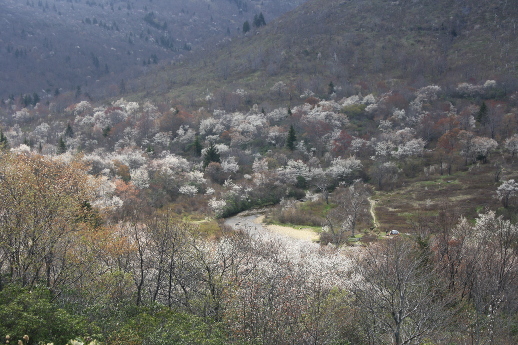Words and picture by Katherine Price.
So it’s March and the crocuses are over and the season has already begun to decay. I’m getting on. There are fewer springs ahead of me than behind. And each stage of the season is weightier than the year before.
I relish the tiny iterations. Three more minutes of light each day. The long tailed tits leaving the gang and pairing up. The rooks returning later and later from their feeding grounds on the Ham Lands, flying over the house west towards their roost. The male black-headed gulls developing their chocolate coloured masks. The daffodils filling the triangle of grass by the roundabout under the A3 at Oxshott. The flooding of the Thames path.
Here in southern England there have been signs of spring since well before Christmas. In the Woodland Garden the beds are mulched by early-December. Any later and the ground is already heaving with the new season, and our boots and barrows trash the first perfect shoots of the early bulbs. In the shortest, darkest days, they nose up through the crumb, bracing themselves for explosive growth, coiled against the twin triggers of sun and rain, the starting pistol for the race to flower and fruit before the tree canopy closes above them and they are robbed of light and water.
I don’t want to let spring go. I want to string it out. And I know how. I know a way to string it out for six months without leaving the northern hemisphere. All you need is latitude or altitude or both.
Naturalist and Pulitzer Prize-winning American writer Edwin Way Teale deals with both in his revelatory book, North with the Spring (1950). It’s his account of a 17,000-mile road trip he made following spring as it travelled up the eastern side of North America. He began in Florida’s Everglades, latitude 26 degrees north, in mid-February and completed his journey at Cape Cod, latitude 42 degrees north, on the summer solstice. In his journey from the south, he held summer at bay.
As for altitude, he writes about it as he travels through the southern Appalachians.
‘The season was advancing swiftest along the valleys; its high-water mark was lifting little by little up the mountainsides. Like floods of water, the floods of spring follow a lowland course. They race ahead down the long valleys, climb slowly, as though struggling with gravity, up the slopes. In the mountains the streams, the highways and the railroads go through the gaps together. And with them goes spring.’
I should have known this. In the 90s I lived in Buxton, the highest market town in England. Friends would leave Manchester in t-shirts for a summer excursion to the Peak District and an hour later and 260m higher they’d be shivering under the ash tree that had yet to come into leaf.
It was another decade before I really understood it though, when I went to Switzerland to work as a gardener. In mid-June I took the cog railway to the famous Swiss botanical garden on the Shining Plateau or Schynige Platte. The railway began at Wilderswil (580m asl) where roses and potatoes were in flower and the dandelions had blown their clocks. The meadows thrummed with insects and the tarmac was hot. The train zigzagged 7 kilometres up the mountain, through the spruce layer, then the pines and out above the treeline. And time travelled backwards. When we reached the garden 50 minutes later and 1500 metres higher, the dandelions were not even in bud and crocus and alpine snowbell were just emerging through the melting snow and winter’s silence still echoed in the brilliant white peaks of the Jungfrau and the Eiger that towered to the south.
Plants have their niches. Crocus vernus subsp albiflorus doesn’t naturally occur on the valley floor. But if you are lucky enough to have both altitude and a botanic garden, you can see the same species in its spring and summer forms on the very same day. It was lovely two-hour journey back down from Schynige Platte (first the cog railway and then the wide-gauge) along the lake to Bern Botanic Garden, where the rock garden was in riotous high season. There, some species – like the yellow bellflower, Campanula thyrsoides – were just going over, a full six-weeks ahead of their siblings on the mountain, whose rosettes were only just beginning to extend.
This sort of time-travel is more challenging in North Carolina. From North Carolina Botanic Garden in Chapel Hill to botanical heaven in the Blue Ridge Mountains is a good five-hour drive (public transport? Don’t make me laugh.) But even driving up the Blue Ridge Parkway in early May, winding back the season as you go, you pass from summer to spring, leaving behind the full-skirted broadwoods in the valleys, climbing through the red oaks still in bud to reach the high plateau with shimmering clouds of serviceberry blossom.
But maybe, ironically, instead of stretching out the season, this kind of time-travel robs you of time itself. All the planning, all the cars, buses, trains, planes. Maybe the only way I can do justice to the dwindling number of springs ahead is to make the most of each one not by dashing around the world but by staying put.
Get to know the shifts in the light. Recognise the birdsong. Absorb the sequence of flowers, from bird cherry to blackthorn to may. Sow seeds for later harvest. Go fishing. Walk. Watch. Listen.
Katherine worked as a gardener at Royal Botanic Gardens, Kew for ten years and now leads the comms team at SOAS. She wrote the ‘Kew Guide’ (2014). Agent Richford Becklow is trying to find a publisher for her first novel, ‘The Greening of Louise Long’.
